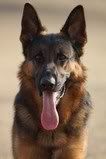Post by saddlebred16 on Mar 21, 2009 21:56:37 GMT -5
The German Shepherd was bred to be a trotting dog meant to gait (trot) for long stretches of time with minimal stress on the dog and minimal fatigue. To do this, the dog must have appropriate anatomy (structure) as well as dry (firm) musculature. To perform the ideal reaching stride, correct angulation of the rear is a must! Without, the dog will not be able to meet (let alone pass) the steps of the front feet with those of the rear. The forward movement starts in the rear of the dog and is transferred forward to the forequarter over the croup and back. This makes the length and position of the croup as well as a short, firm back, or great importance. Correct angulation of the rear and well muscled thighs enable the dog to have a powerful rear drive. Limitations in angulation influence the length of the stride. The forequarter has the responsibility to complete the forward movement action and "catch" the body. For the largest possible length of stride, the correct angulation of the forequarter, with correct length and position of the upper arm and shoulder blade are needed. This allows full extension and a 'reaching' gait. Anatomical faults influence the harmonic movement as faults in the topline disrupt the line over which the energy of the forward motion is conveyed. A soft or broken topline acts as a brake causing the dog to fall on the forequarter.
Correct gaiting is a beautiful thing to behold when performed correctly and effortlessly.

Correct gaiting is a beautiful thing to behold when performed correctly and effortlessly.


